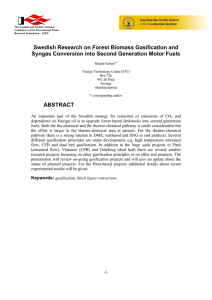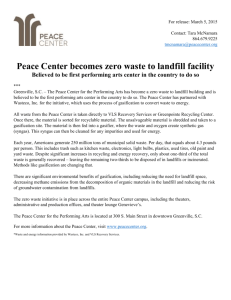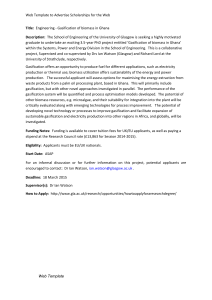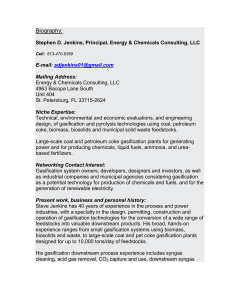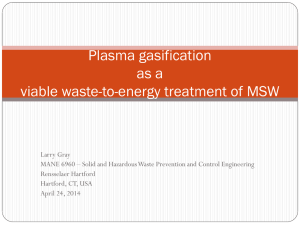Carbon conversion predictor for fluidized bed gasification Jukka Konttinen, Jason Kramb, Roshan Budhathoki
advertisement
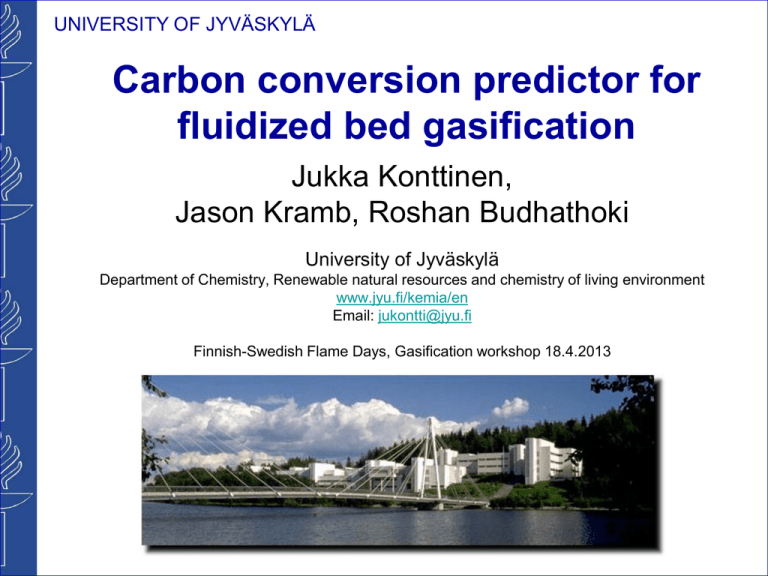
UNIVERSITY OF JYVÄSKYLÄ Carbon conversion predictor for fluidized bed gasification Jukka Konttinen, Jason Kramb, Roshan Budhathoki University of Jyväskylä Department of Chemistry, Renewable natural resources and chemistry of living environment www.jyu.fi/kemia/en Email: jukontti@jyu.fi Finnish-Swedish Flame Days, Gasification workshop 18.4.2013 UNIVERSITY OF JYVÄSKYLÄ CONTENTS Introduction Experimental / methodology – Converting kinetic parameters from TGA data (fluidized bed) – Fixed bed modeling Modeling – Fluidized-bed gasification – Fixed-bed gasification Conclusions UNIVERSITY OF JYVÄSKYLÄ RECENT BOOK ABOUT BIOREFINERIES Papermaking Science and Technology, Book 20: Biorefining of Forest Resources. Alén R. (ed.), Published by Paper Engineer’s Association. Bookwell Oy, Porvoo, Finland 2011. ISBN 978-952-5216-39-4. – Chapter 8: Konttinen, J.; Reinikainen, M.; Oasmaa, A. and Solantausta, Y.: Thermochemical conversion of forest biomass Pp. 262-304 UNIVERSITY OF JYVÄSKYLÄ Gasification reactors to be modeled Fluidized bed [1] Downdraft fixed bed [1] GAS FUEL AIR ASH UNIVERSITY OF JYVÄSKYLÄ Carbon conversion predictor Oxidation of char carbon is the slowest step in the gasification of solid fuels – Contributes to gasifier efficiency (overall fuel conversion) – Contributes to the quantities and properties of ashes Gasification reactivity of waste and biomass chars is different from that of solid fossil fuels [2, 3] – Particle size – Rate of pyrolysis – Catalytic properties of ash (inhibition by CO/H2) Should not just be another curve-fitting exercise… – Simple and transparent parameter fitting and modelling – With reasonable cost and effort UNIVERSITY OF JYVÄSKYLÄ Carbon conversion predictor • Schematic diagram of the overall carbon conversion predictor model [3] • Inputs are intended to be based on relatively simple experimental tests on fuel samples (e.g. TGA) UNIVERSITY OF JYVÄSKYLÄ Carbon conversion predictor Schematic diagram of the updated FBG component of the predictor model [3] Includes correlations for residence time and conversion calculations from Gómez-Barea and Leckner [7] UNIVERSITY OF JYVÄSKYLÄ Downdraft fixed bed gasification model [5, 6] The gasification process is conceived to follow a particular sequence of drying, pyrolysis, oxidation and reduction process Drying and pyrolysis that comprises of a sub-model is formulated based on empirical and stoichiometric equilibrium modeling approach. Oxidation (partial) process is also framed on stoichiometric equilibrium model The sub-model for reduction process is established on finite kinetic modeling approach. – Reduction process is accredited with an essential phenomenon during gasification process and encompasses several gasification reactions. [5, 6] Thus, the model can be used to – analyze the influence of moisture content and equivalence ratio on the product gas composition, heating value and carbon conversion. – the model may help in optimizing the gasification process in a downdraft gasifier. UNIVERSITY OF JYVÄSKYLÄ Downdraft fixed bed gasification model [6] UNIVERSITY OF JYVÄSKYLÄ CONTENTS Introduction Experimental / methodology – Converting kinetic parameters from TGA data (for fluidized bed modeling) – Fixed bed modeling Modeling – Fluidized-bed gasification – Fixed-bed gasification Conclusions UNIVERSITY OF JYVÄSKYLÄ Char carbon gasification conversion of TGA data [3] 12 SRF 2, 100 % H2O SRF 1, 100 % H2O SRF 2 100 % CO2 SRF 1 100 % CO2 Birch wood 800 C, 100 % H2O 8 6 r' ' = 4 1 dw w dt 2 0 0 200 400 600 800 1000 1200 1400 1600 Time (s) 250 Insttantaneous rate r'' (1/min) Weight (mg) 10 SRF 2, 100 % H2O SRF 1, 100 % H2O SRF 2 100 % CO2 SRF 1 100 % CO2 Birch wood, 800 C, 100 % H2O 200 150 100 50 0 80 85 90 95 Carbon conversion (%) 100 UNIVERSITY OF JYVÄSKYLÄ 100 Average reactivity (1/s) = f(T, ptot,pH2O,pCO2,pCO,pH2) Char after slow treatment Instantaneous reaction rate, wt % /min 90 Char after fast heat treatment (3 min) 80 70 Correlations (wood, small dp) [3, 4]: Char after fast heat treatment (1 min) 60 R C−CO 2 = 50 40 k 1f PH 2O k 1f PCO 2 R C− H 2O = k k k k 1 + 1f PH 2O + 1b PH 2 1 + 1f PCO 2 + 1b PCO k3 k3 k3 k3 30 Minimize: 20 To find: ⇒ k01f,k01b,k03 −R ) L = ∑ (R E1f,E1b,E3 by Levenberg-Marquardt method N 10 2 C exp 0 j 0 20 40 60 Char conversion, % 80 100 C mod el j Kinetic parameters for Char Carbon Reactivity [3] UNIVERSITY OF JYVÄSKYLÄ CONTENTS Introduction Experimental / methodology – Converting kinetic parameters from TGA data (fluidized bed) – Fixed bed modeling Modeling – Fluidized-bed gasification – Fixed-bed gasification Conclusions UNIVERSITY OF JYVÄSKYLÄ Downdraft fixed bed gasification model The kinetic model for the gasification reactions are of Arrhenius type [5, 6] Reactions Reaction rate (mol/m3.s) Boudouard reaction: C + CO2 ↔ 2CO y2 − E 1 r1 = C RF A 1 exp ⋅ y CO 2 − CO K eq ,1 RT Water-gas reactions: C + H2O ↔ CO + H2 yCO ⋅ y H 2 − E 2 r2 = CRF A 2 exp ⋅ yH 2O − K eq , 2 RT Methane formation: C + 2H2 ↔ CH4 y CH 4 − E 3 2 r3 = C RF A 3 exp ⋅ y H2 − K eq ,3 RT Steam reformation: CH4 + H2O ↔ CO + 3H2 yCO ⋅ y3H 2 − E 4 r4 = A 4 exp ⋅ yCH 4 ⋅ y H 2 O − K eq , 4 RT In the reaction rate equation, CRF refers to char reactivity factor, A & E are the kinetic parameters, yi is the mole fraction of the chemical species involved in the gasification process For example, the rate of formation or destruction of CO can be estimated as; RCO = 2r1 + r2 + r4. The reduction zone is partitioned into n number of compartments. UNIVERSITY OF JYVÄSKYLÄ CONTENTS Introduction Experimental / methodology – Converting kinetic parameters from TGA data (fluidized bed) – Fixed bed modeling Modeling results – Fluidized-bed gasification – Fixed-bed gasification Conclusions UNIVERSITY OF JYVÄSKYLÄ Carbon conversion predictor results 1 0.9 Carbon conversion (-) 0.8 SRF 0.7 Wood 850°C Wood 900°C 0.6 Wood 950°C Wood 0.5 Wood 1000°C Coal 850°C 0.4 Coal 900°C 0.3 Coal 950°C Coal 1000°C Coal 0.2 M Cbed τC = mCf SRF 850°C SRF 1000°C 0.1 0 1 10 100 1000 10000 100000 1000000 τ C (kg C/kg C/s ) Konttinen et al. [3] UNIVERSITY OF JYVÄSKYLÄ Carbon conversion predictor Results based on preliminary modeling work Updated model results show good similarities with previous work Results match well with pilot scale data UNIVERSITY OF JYVÄSKYLÄ Downdraft fixed bed gasification model Composition comparisons with experimental data of Jayah el al. [5, 6]. The data label refers to absolute error in prediction of corresponding gaseous species. (ER = equivalence ratio). UNIVERSITY OF JYVÄSKYLÄ Carbon conversion predictor, future work Implement conversion dependent reactivity equations into reactor model Time dependendent, non-steady state/dynamic behavior UNIVERSITY OF JYVÄSKYLÄ References 1. Konttinen J, Reinikainen M, Oasmaa A, and Solantausta Y Thermochemical conversion of forest biomass (Chapter 8). In: Papermaking Science and Technology, Book 20: Biorefining of Forest Resources. Alén R. (ed.), Published by Paper Engineer’s Association. Bookwell Oy, Porvoo, Finland 2011. Pp. 262-304. ISBN 978-952-5216-39-4. 2. Moilanen A, Thermogravimetric characterisations of biomass and waste for gasification processes. Academic dissertation, Abo Akademi University. Espoo 2006. VTT Publications 607. 103 p. + app. 97 p. 3. Konttinen, J.; Moilanen, A.; DeMartini, N and Hupa, M.: Carbon conversion predictor for fluidized bed gasification of biomass fuels – from TGA measurements to char gasification particle model. Biomass Conversion and Biorefinery, 2 (2012) 3, pp. 265-274. http://dx.doi.org/10.1007/s13399-012-0038-2 4. Barrio, M Experimental investigation of small-scale gasification of woody biomass. Academic dissertation, The Norwegian University of Science and Technology, Faculty of Engineering Science and Technology, Department of Thermal Energy and Hydropower. Trondheim., Norway, May 2002. 5. Jayah, TH, Aye, L, Fuller RJ, Stewart DF, "Computer simulation of a downdraft wood gasifier for tea drying," Biomass Bioenergy, vol. 25, pp. 459-469, 10, 2003. 6. Budhathoki, R, Three zone modeling of Downdraft biomass Gasification: Equilibrium and finite Kinetic Approach. Master’s Thesis. University of Jyväskylä, Department of Chemistry, Finland, April 2013. 7. Gómez-Barea A, Leckner B, Estimation of gas composition and char conversion in a fluidized bed biomass gasifier, Fuel 107 (2013), pp. 419–431. http://dx.doi.org/10.1016/j.fuel.2012.09.084 UNIVERSITY OF JYVÄSKYLÄ CONTENTS Introduction Experimental / methodology – Converting kinetic parameters from TGA data (fluidized bed) – Fixed bed modeling Modeling results – Fluidized-bed gasification – Fixed-bed gasification Conclusions UNIVERSITY OF JYVÄSKYLÄ Conclusions High system efficiency requires good carbon conversion in the gasifier The reactivity of the char in gasification reactions (between char carbon and steam and CO2 as well as the inhibiting reactions of product gases H2 and CO) play a significant role in reaching good carbon conversion in a hot fluidized bed The gasification reactivity data of biomass chars, as measured in TGA experiments, is used for the determination of kinetic parameters for char carbon gasification reactivity correlations UNIVERSITY OF JYVÄSKYLÄ Conclusions Laboratory measured reactivity values from TGA experiments are used in the Carbon Conversion predictor to simulate carbon conversion in a real scale fluidized bed gasifier The predictor is a relatively simple and transparent tool for the comparison of the gasification reactivity of different fuels in fluidized bed gasification Also a three-zone model for fixed bed gasification has been developed, based on models and parameters from the literature. Simulations with the models against some pilot-scale results show reasonable agreement UNIVERSITY OF JYVÄSKYLÄ Acknowledgments The ongoing projects GASIFREAC and IMUSTBC (Sustainable energy CNPq) are financed by the Academy of Finland, which support is gratefully acknowledged
